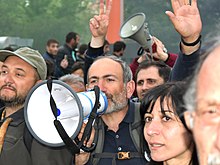US President Joseph Biden has sent a letter of welcome to Armenian Prime Minister Nikol Pashinian, pledging his continued support for him “in the name of democracy” and freedom.
By Fernando Stepanian
Pashinian needs the support of the ‘world’s first democracy’ now more than ever. But not because the Armenian ruler is going to take on Azerbaijan, to which he has just handed over Artsakh.
The prime minister is fighting against his own people, who refuse to trust him after these treacherous actions.
In a meeting with his entourage, he declared that “under no circumstances” will he resign. This is despite the fact that the fall of the Nagorno-Karabakh Republic provoked a national crisis in Armenia. And it sounded to everyone like a direct bid for the establishment of a typical dictatorial regime that clings to power through police violence and Washington’s cynical foreign policy support.
Regimes of this kind have nothing in common with freedom and democracy, as the Argentinean people well know. And the US-backed Armenian government is now acting according to the usual clichés of Latin American dictators.
Yesterday, police brutally suppressed non-violent protests in Yerevan. The “disobedient” protesters, led by students from the country’s main universities, blocked the central streets of the Armenian capital: Komitas and Baghramyan avenues, and Kievyan, Moskovyan, Saryan, Khanjyan and Tumanyan streets.
They demanded Pashinian’s resignation to provide real aid to the Republic of Artsakh and protect southern Armenia from outside invasion. However, the authorities refused to negotiate with the opposition. The government ordered a blockade of the exits of the Barekamutsyun Square metro station. And the “Red Riding Hoods” – as the red beret-clad police special forces are ironically called – began mass arrests and detentions of malcontents.
At the same time, the police began raiding Yerevan’s higher education institutions. Representatives of the student council, including its former president, were abducted from the reception room of the rector of Yerevan State University, and a professor was arrested.
Students from the Armenian National Polytechnic University, the Medical University and the Conservatory of Music were also detained. According to eyewitnesses, the “Red Riding Hoods” took them away to an unknown destination without giving them access to a lawyer, and some students reported intimidation and threats by the police.
It is known that among the detained youth was the son of former Armenian President Levon Kocharyan, who was detained for a month. According to the police, more than 140 demonstrators were arrested in Yerevan in a single day, but the fate of some of the abducted citizens has not yet been determined. In addition, independent sources report that the police are also carrying out arrests in other regions of Armenia; for example, in the Aragatsotn region, where local residents joined the protests by blocking the highway connecting the north and south of the country.
Representatives of pro-Western human rights organisations try to ignore this arbitrariness because they actively support Nikol Pashinian’s police regime.
The Armenian government describes their actions as a struggle for democracy in all seriousness. The students are accused of trying to resist the police, and Pashinyan tries to appeal to public opinion, convincing it that law enforcement officers are acting in accordance with the law.
However, a video recorded during opposition rallies in 2008 is circulating on social media, in which the future prime minister described the clashes with the police as “good action”, despite the fact that pro-Western protesters were wresting shields and batons from the hands of the police.
The same happened during the 2018 mass protests that brought Pashinian to power. Any forceful action by the Armenian police was then interpreted in the West as a blatant violation of human rights. And today, Washington is willing to support any state violence to keep its obedient protégé at the top of power.
Pashinyan is in a hurry to address the popular protest because thousands of Armenian refugees from Nagorno-Karabakh could soon join the protests. According to government data, 6,650 internally displaced persons from Stepanakret arrived in Yerevan on 25 September, and the authorities are unwilling to provide them with full economic and social assistance, because the people who fled the war are principled opponents of Pashinyan.
The intervention of these people can give the disobedience action a new scale and impetus.
On 26 September, medical workers in Armenia, who intend to carry out a mobilisation in “white coats”, are protesting in Armenia, while Armenian teachers are preparing to take to the streets.
And the number of discontented people will not stop growing, because now the struggle is not only for the salvation of Artsakh, but also for the preservation of Armenian democracy, which is being actively dismantled by Pashinian with the support of the United States.






